
By Bob Goemans

Substrate is usually regarded as the bed of material that covers the aquarium bottom. The purpose of this bed is twofold; that of providing a natural looking 'lagoon-like' bottom area and, an area of biological filtration. And there’s been much discussion over the past couple of decades about the different types of material that can be used to cover aquarium bottoms and that of its depth. To adequately discuss these aspects, lets first look at the various mediums used and some of their important aspects, then shift to their applications and the results that can be expected from them.
The Materials
Aragonite
This easily dissolved form of calcium carbonate begins to dissolve at a pH of 8.2, making it a highly suitable material in reef aquaria where mineral demands are higher than in fish-only aquariums. 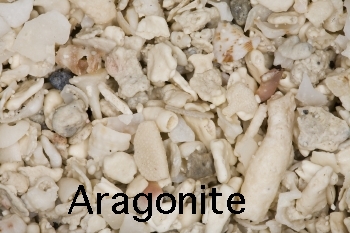 Most other forms of calcium carbonate only begin to dissolve when pH is approximately 7.8 or lower, which is rarely reached in marine aquariums. Additionally, orthophosphate coatings do not affect its dissolution, while other forms of calcareous material are impacted. This may be a reason why it provides a more stable pH and enhanced growth rate for stony corals and clams when compared to other forms of calcium carbonate material. It's also highly porous and angular shaped with rough surface areas, allowing for good bacteria adhesion and diffusion.
Most other forms of calcium carbonate only begin to dissolve when pH is approximately 7.8 or lower, which is rarely reached in marine aquariums. Additionally, orthophosphate coatings do not affect its dissolution, while other forms of calcareous material are impacted. This may be a reason why it provides a more stable pH and enhanced growth rate for stony corals and clams when compared to other forms of calcium carbonate material. It's also highly porous and angular shaped with rough surface areas, allowing for good bacteria adhesion and diffusion.
Coral Sand
Usually a calcareous material and naturally occurring along the shoreline of many beach areas or in lagoons. It's generally produced through wave action breaking over old coral skeleton material or the rolling motion of coral pieces in turbulent areas, which slowly reduce it to sand particles of various sizes. Parrotfish, which feed on stony corals for their zooxanthellae by grinding their beak-like teeth on their surfaces, also produce the sand. It may consist of aragonite or calcite, sometimes both. Its particles are often smooth sided and small, about 1 mm, thereby somewhat reducing bacteria adhesion sites. 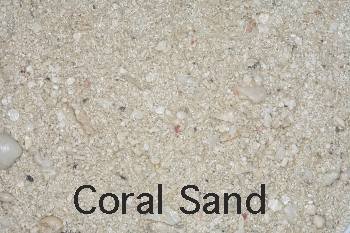 It is wise to know where it's collected, because if its 'beach' collected it may contain an inordinate amount of organic material, as human wastes and petroleum from ships and natural seepage may find its way onto this medium. Depending upon its origin, grain size varies, as does its color.
It is wise to know where it's collected, because if its 'beach' collected it may contain an inordinate amount of organic material, as human wastes and petroleum from ships and natural seepage may find its way onto this medium. Depending upon its origin, grain size varies, as does its color.
Crushed Coral
One must carefully select this product, as different materials called crushed coral are available. And keep in mind; this product is ‘not’ made up of crushed pieces of broken coral skeletons. It’s mostly crushed limestone from ancient reef areas and depending upon their location, can either be mostly aragonite or calcite. 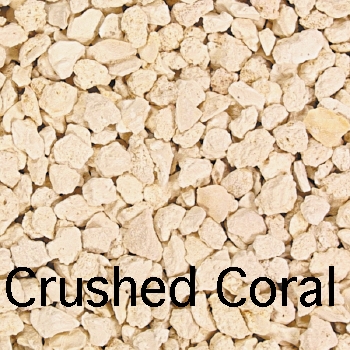 The material mostly coming from various mainland USA areas is basically a calcite product, having a solubility in the pH range of 7.2 – 7.6. The product generally coming from the Caribbean is mostly aragonite, making it more suitable for reef aquaria, as it begins to dissolve at a pH of 8.2.
The material mostly coming from various mainland USA areas is basically a calcite product, having a solubility in the pH range of 7.2 – 7.6. The product generally coming from the Caribbean is mostly aragonite, making it more suitable for reef aquaria, as it begins to dissolve at a pH of 8.2.
This ‘mined’ material is then crushed and graded to a grain size useful for marine aquariums, e.g., 2 - 6 mm, and its physical grain structure is very porous with sharp irregular edges providing very good attachment sites for bacteria. Sometimes, shell material finds its way into some mixes, and since some shell material contains considerable amounts of phosphate and heavy metals, its advisable to select brands that are shell free.
Oolitic Sand
'Oolitic' is a term used to describe the shape/structure of this particular sand grain, which consists of concentric layers (like an onion) of calcium carbonate that surround tiny remains of coral skeleton, invertebrate shell, calcareous Halimeda algae, and varying amounts of calcite. 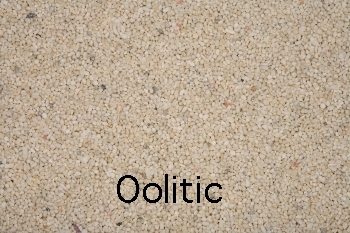 It's shaped differently than the more pure aragonite products, as this chemical precipitate of seawater that occurs when cold calcium rich waters get carried into shallow warm tropical seas, is mostly round. Furthermore, even though most oolitic sands contain aragonite, the land mined products from southern Florida, i.e., Miami Limestone or Key Largo Limestone, have a far greater percentage of calcite and considerably less strontium than do its Bahamian Bank counterpart, making the Bahaman Banks products more desirable for reef aquaria. Even though it’s technically correct to call all these products an ‘oolitic aragonite sand,' products that are largely aragonite, i.e., having a far greater percentage of aragonite, render far more buffering. Nevertheless, because of its smooth rounded shape, sites for bacteria adhesion are not as good as they are with courser-grained material.
It's shaped differently than the more pure aragonite products, as this chemical precipitate of seawater that occurs when cold calcium rich waters get carried into shallow warm tropical seas, is mostly round. Furthermore, even though most oolitic sands contain aragonite, the land mined products from southern Florida, i.e., Miami Limestone or Key Largo Limestone, have a far greater percentage of calcite and considerably less strontium than do its Bahamian Bank counterpart, making the Bahaman Banks products more desirable for reef aquaria. Even though it’s technically correct to call all these products an ‘oolitic aragonite sand,' products that are largely aragonite, i.e., having a far greater percentage of aragonite, render far more buffering. Nevertheless, because of its smooth rounded shape, sites for bacteria adhesion are not as good as they are with courser-grained material.
Calcite
This is another form of calcium carbonate, somewhat softer than dolomite, yet not much. It begins to dissolve between a pH of 7.2 to 7.6 (metastable range), and can be considered a very suitable substrate for undergravel filter systems, yet of little value where some calcium buffering would be helpful. Calcite products, generally mined and crushed limestone from ancient reef deposits (see crushed coral above) are ineffective buffers in marine aquariums.
Dolomite
This commonly mined calcium, magnesium, carbonate mineral, is less soluble than calcite or some crushed shell products and provides far less buffering, if any, than other forms of material. Large deposits of this mineral are crushed, washed and screened and sold as garden/lawn decorations, and/or substrate for some types of freshwater and marine systems. Their highly rough surfaced particles work well for bacteria adhesion and also space well because of their angularity, thereby allowing for good water flow. Since Dolomite has little or no solvency in the marine aquarium, yet has excellent attachment sites for bacteria, it’s an excellent substrate for undergravel systems. It should be washed well to remove any dust-like material that coats or accompanies the material, as it can be high in trace amounts of aluminum, arsenic, lead, and/or mercury. The dolomite particle has a metastable range of the high 6 to low 7 range.
Oyster Shell/Crushed Shell
As with crushed coral, there are choices. Crushed oyster shell, mostly calcite, is just that and is sold both at feed stores as chicken feed, and in some pet shops as substrate for marine aquariums. It usually contains a lot of calcareous dust and therefore requires a thorough washing before use. Even though two or three washings may fail to remove all the milky white calcareous dust attached to the shell particles, it’s safe to use. However, this material is ‘flat’ pieces of shell and may pack tightly over a period of time thereby restricting diffusion. Additionally, oyster shell pieces have smooth surfaces, making it difficult for bacteria to adhere, and the larger the particle the less total surface area in a given volume when compared to small sand grains for bacteria to adhere to. 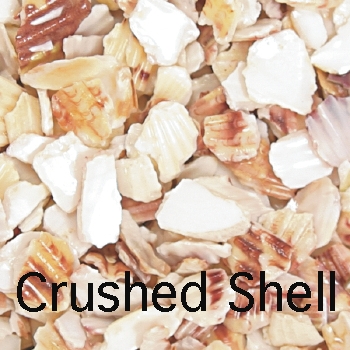
Nevertheless, other type shell material, such as Puka shell, favor aragonite in their structure and would be far more suitable for substrate use in marine aquaria. So there are choices as to shell material, yet keep in mind particle size and their shape, as these aspects affect diffusion and bacterium sites. Also of importance, as explained above, some shelled animals are algae grazers, and if so, the shell material may contain phosphate and heavy metals.
Silica Sand
This non-calcareous material is usually sold by home improvement or lumberyards in three different particle sizes, e.g., #20, 40, and 60. The higher the number, the smaller the particle size. Number 60 is what might be seen in cigarette urns. This 'very' fine silica sand is easily moved about by water currents or aquaria animals and can easily end up deposited on your live rock or corals. Been there, done that, and had those results with my aquarium looking as if a snowstorm just passed through it! Number 40 is also a bit too small and can also be easily shifted about by fish or water currents. This leaves number 20, which has a particle size of about 1/20th inch (1 mm). As a note, size 40 is 1/40th of an inch (<1 mm), and size 60, you guessed it! Size 20 appears to be the best of the three commonly found sizes as it mostly stays in place even where there are fairly swift current flows.
There are both positive and negative aspects associated with its use. When phosphate precipitation occurs, it will not adhere to the silica particle as calcium phosphate (apatite) as it does on a calcareous material. Depending upon the aquarium environment and bioload, that could be viewed as either a positive or negative aspect. On the positive side, its very 'white' color renders a pretty, natural looking ‘lagoon-like' bottom. Probably the most negative aspect is there is some minor dissolution with the product in alkaline water above a pH of 8.0. And the rate of dissolution increases when pH reaches 8.5 and because of that, brown diatom algae can be greatly encouraged. Because it can cause diatom algae, does not buffer water as does a calcareous material, and its particles are smooth sided, it has limited use in marine aquaria.
Industrial Sands
These calcareous sands' may be products used for abrasive purposes, such as in the glass making/painting industry, and are often sold off when their exterior grain surfaces lose their abrasiveness. One should keep in mind when products such as these are originally selected and used by these companies; their original contaminations or those creeping in while being utilized are not of concern. Therefore, on-going use of the products in aquaria as a calcareous substrate should be evaluated carefully before using them. Furthermore, its particle surface has now been smoothed, thereby greatly reducing attachment sites for bacteria.
Mud
A lot of companies have entered the market with ‘mud-like’ products. All are very fine grained and highly nutrient-rich sediments, sometimes nothing more than what can be found in old drained swamps or sold in local florist shops as potting soil. Nevertheless, when properly used in aquaria, e.g., refugia, it provides fertile grounds for excellent algae growth.
Grain Size
The physical size and shape of the grains has a lot to do with the results one can expect from their use, as this and the depth of the product will dictate the volume and class of bacterium that will inhabit it. With grains below 2 mm, it has been thought that the more grains there is in a given area, the more bacteriia there would be living on them, which should logically result in improved filtration processes. Not exactly correct since very small grains pack together very tightly and there is less space between them. When this happens oxygen diffusion into and through the bed is restricted, thereby reducing the volume of the areas where the more valuable biological processes occur, e.g., mineralization, nitrification and 'destructive' denitrification. Basically it's more bacteria but not the right volume of the right 'class' of bacterium.
If grain size were too large, e.g., 8 mm or above, it would allow oxygen to penetrate much deeper, thus inhibiting denitrification by extending the depth of upper oxic/oxygen rich zone. Detritus penetration is also quite feasible and if this occurs due to poor maintenance, oxygen penetration can then be greatly reduced if it collects and would then result in the development of a microenvironment that produces its own needs and shunts the essential diffusion that would normally produce useful denitrification in the bed. A probable result would be single cell algae and diatoms colonizing it first with more complex multi-cellular algae and structured algal mats soon to follow. Nevertheless, if a nutrient rich environment is desired, the use of large grains can help further that goal.
Substrate Depths
The two most popular bed depths are the shallow bed, i.e., 1 - 2 inches (2.5 - 5 cm) or the deep bed, approximately 4 inches (10 cm) or deeper. Either can be successful, yet one should understand which method is more dependent on what entities, i.e., bacterium and/or infauna for the majority of its results!
Keeping in mind that grain size affects oxygen penetration, lets use the more common 2 – 5 mm grained sand, and create a shallow 1 – 2 inch (2.5 – 5 cm) bed. In the top half-inch (1 cm) of depth, the inorganic results (ammonia) from aerobic heterotrophs elsewhere in the aquarium enters and the aerobic autotrophs living on the sand grains here reduce the ammonia to nitrite and nitrate. Just below this level, in approximately the next half inch of depth, facultative anaerobic heterotrophs live where there’s still a small amount of oxygen, and they reduce the nitrate to nitrogen gas, which dissipates harmlessly upward through the bed and into the water column. Below this in an area of less or no oxygen, only obligate anaerobic heterotrophs can survive, and what nitrate reaches this class of bacterium is only reduced to ammonium. This ammonium can leach upwards and again go through the reduction cycle, or if in excess, can reach the substrate/water column interface and initiate unwanted algae growth. Whether it does often depends upon the level of aquarium bioload, as a system that is overcrowded/overfed is more liable to experience unwanted growths of algae. However, in shallow beds such as this, the area containing obligate anaerobic heterotrophs is only about an inch in depth. Therefore, very little ammonium is produced.
It then seems more microbial efficient to stay away from overly deep beds that have far greater areas of little or no oxygen, yet there are those that prefer them and depend more upon infauna to ingest, consume, and reduce the ever-growing amount of incoming detritus and inorganic compounds. Nevertheless, no matter how many worms and crustaceans that prowl the depths of the bed, they too produce poop that needs to be reduced, and the phosphate they produce may be released into the bulk water via their tunneling/burrowing. And in my opinion, when it comes to grain size and depth, I can accurately say what class of bacterium exist and where. But I cannot do so when it comes to infauna, nor can I say how many of what species exist and where they are in the bed. So I see it as shallow beds having the best of both worlds - less area for ammonium production and some infauna that helps bed mechanics function. It’s also more easily vacuumed monthly, as keeping the bed clean aids the long-term health of the system.
As for mud systems, there is no oxygen penetration except for what infauna can bring about, therefore the bed is extremely nutrient rich, which is exactly why such a medium is chosen, i.e., to facilitate the growth of macroalgae, which in turn, if managed correctly, can assimilate some of the nitrogen-laden compounds that naturally enter aquarium water.
In closing, I’ve seen all kinds of bed depths, mud systems, and even bare-bottom tanks that were quite successful. It tells me that when the aquarist provides the correct system husbandry, i.e., a well-balanced system that is not overcrowded or overfed; any form of bed choices can be successful. Nevertheless, all of the above was written so that the reader would come away with some insight to the aspects discussed, as it may help in designing and maintaining a future system, or systems not now operating as expected.
My thanks to Tony Wagner at CaribSea for providing the photos.